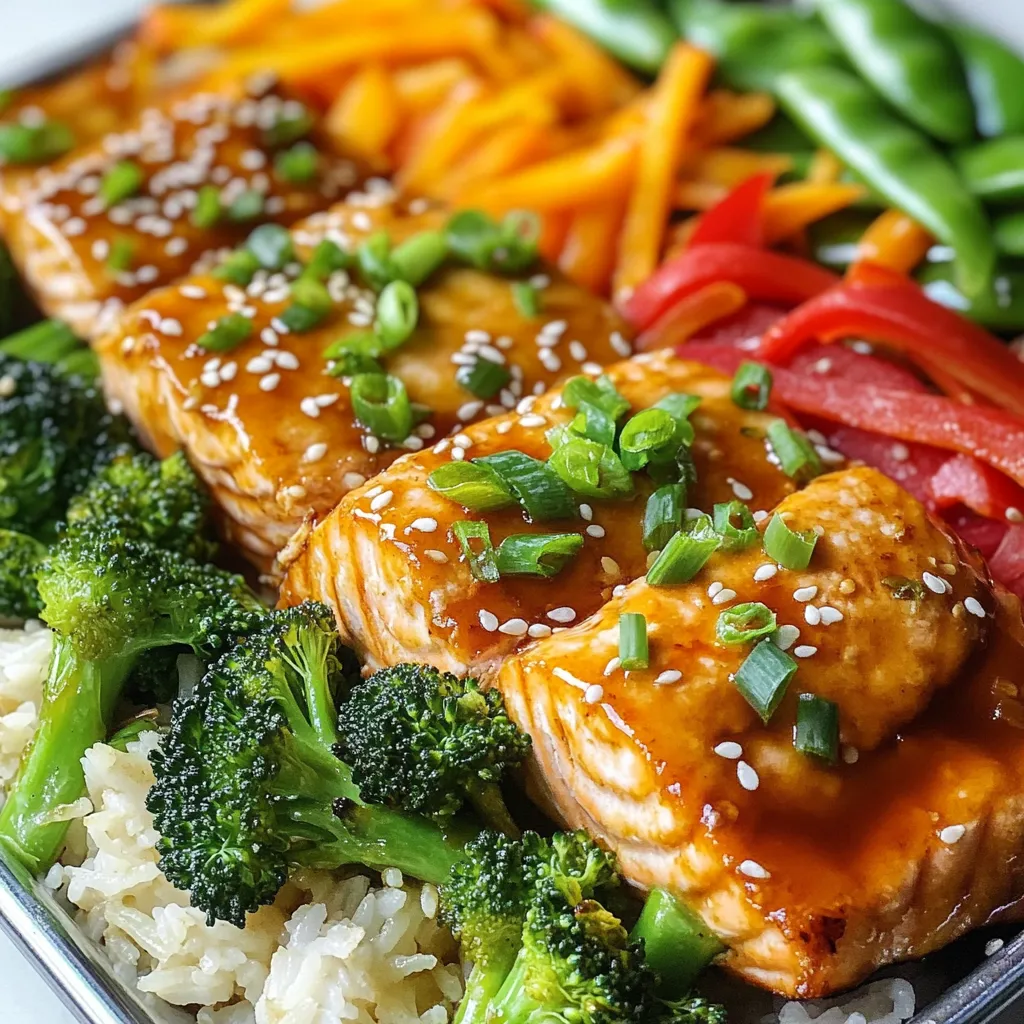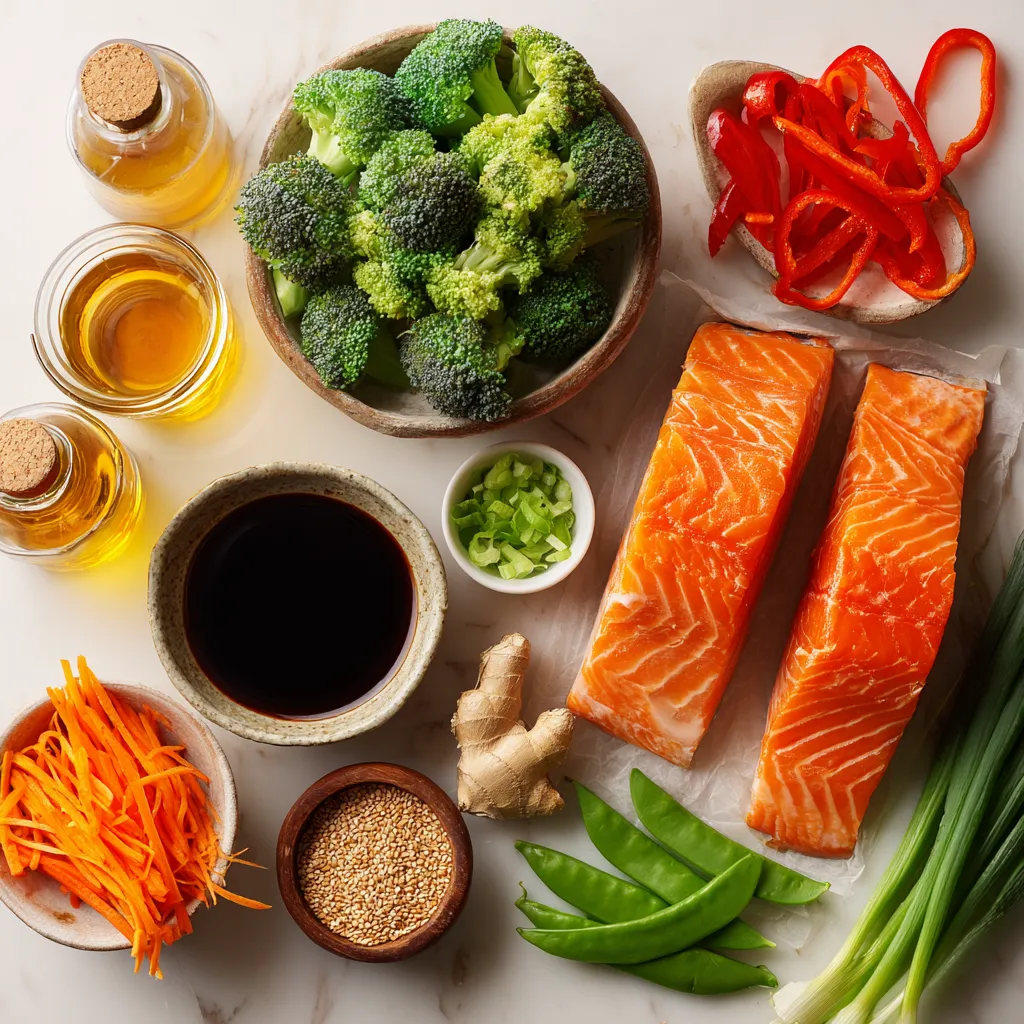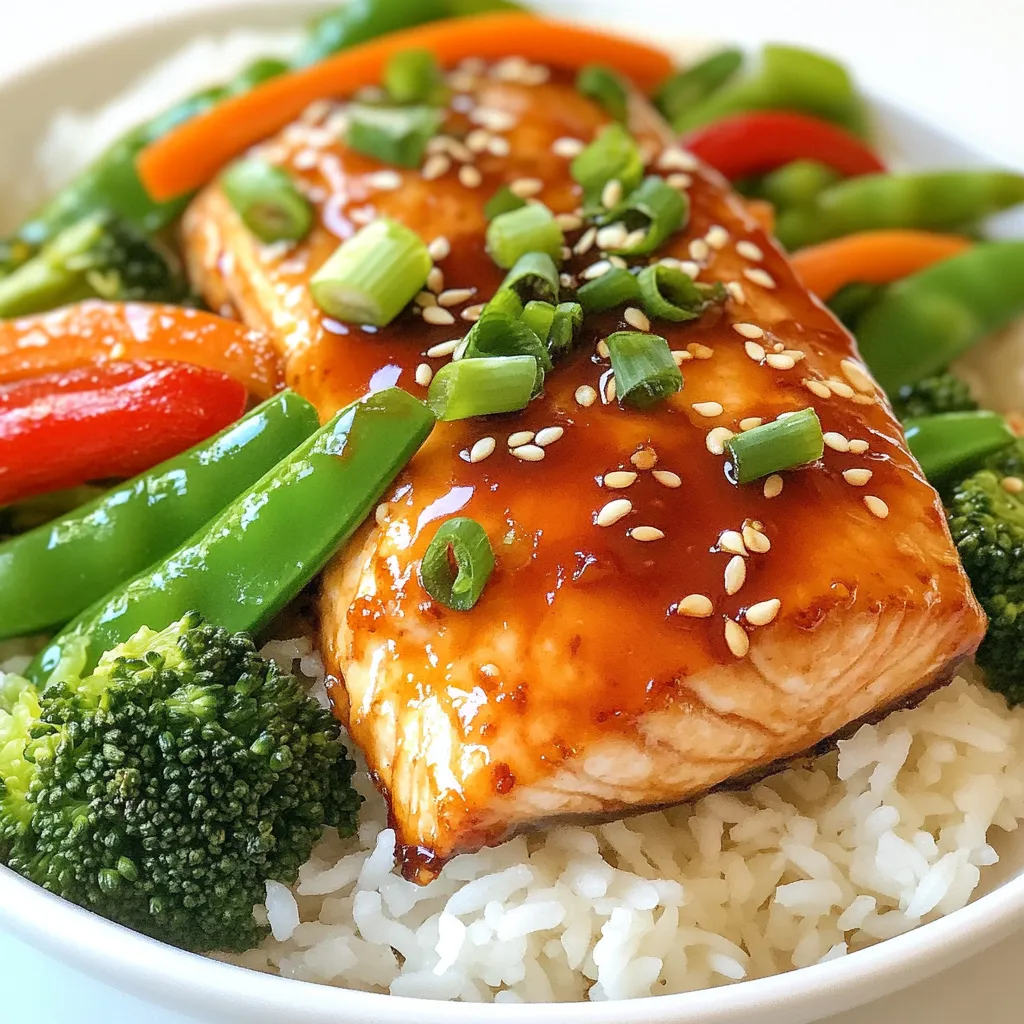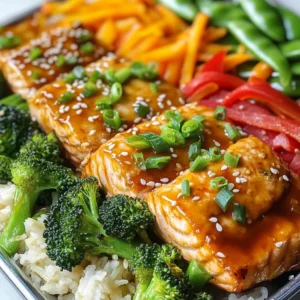WANT TO SAVE THIS RECIPE?
Looking for a quick and tasty dinner? You’ll love this Sheet Pan Teriyaki Salmon and Veggies recipe! It’s simple, healthy, and bursting with flavor. In just a little time, you can whip up a meal that pleases everyone. With juicy salmon and vibrant veggies, it’s perfect for busy weeknights or meal prep. Let’s dive into the ingredients and start making a dinner that shines!

Why I Love This Recipe
- Quick and Easy: This recipe comes together in just 30 minutes, making it perfect for busy weeknights.
- Flavorful Teriyaki Sauce: The homemade teriyaki sauce is a delightful blend of sweet and savory, enhancing the taste of both salmon and veggies.
- Nutritious and Colorful: Packed with vibrant vegetables, this dish is not only visually appealing but also a healthy choice for dinner.
- One-Pan Wonder: The sheet pan method means less cleanup, allowing you to enjoy your meal without the hassle of multiple dishes.
Ingredients
Main Ingredients for Sheet Pan Teriyaki Salmon
– 4 salmon fillets (6 oz each)
– 2 cups broccoli florets
– 1 red bell pepper, sliced into strips
– 1 cup snap peas
– 1 large carrot, julienned
I love using fresh salmon for this dish. It cooks quickly and tastes amazing. The green veggies add color and nutrition. Broccoli and snap peas are my favorites here.
Teriyaki Sauce Components
– 1/4 cup low sodium soy sauce
– 2 tablespoons honey or maple syrup
– 1 tablespoon freshly grated ginger
– 2 cloves garlic, minced
– 1 tablespoon sesame oil
– 1 teaspoon cornstarch mixed with 2 tablespoons water (for thickening)
The teriyaki sauce is what makes this dish special. It’s sweet and savory. Fresh ginger and garlic give it a nice kick. Using low sodium soy sauce keeps it healthier, too.
Suggested Seasonings for Flavor Enhancement
– Salt and pepper, to taste
– 2 tablespoons sesame seeds
– Sliced green onions, for garnish
Seasoning is key to any great dish. A pinch of salt and pepper can elevate the flavors. Adding sesame seeds and green onions on top makes it look pretty and taste even better.

Step-by-Step Instructions
Preparing Your Oven and Sheet Pan
First, preheat your oven to 400°F (200°C). This helps the salmon cook evenly. While the oven heats, take a large sheet pan and line it with parchment paper. This prevents sticking and makes cleanup easy.
Mixing the Teriyaki Sauce
Next, grab a small mixing bowl. Combine the low sodium soy sauce, honey or maple syrup, freshly grated ginger, minced garlic, and sesame oil. Whisk until smooth. To thicken the sauce, add the cornstarch mixed with water. Stir well until it is fully blended.
Marinating the Salmon and Arranging the Vegetables
Lay the salmon fillets on one side of the sheet pan. Pour half of the teriyaki sauce over the salmon. Make sure the fillets are well coated. Let them marinate for about 10 minutes. Meanwhile, on the other side of the sheet pan, arrange the broccoli, red bell pepper, snap peas, and julienned carrot. Drizzle the remaining teriyaki sauce over the veggies. Toss gently to coat them. Season with a pinch of salt and pepper.
Baking Instructions and Cooking Times
Now, place the sheet pan in the preheated oven. Bake for about 15 to 20 minutes. The salmon is ready when it flakes easily with a fork and reaches 145°F (63°C) inside. The veggies should be tender but still crisp. When done, remove the sheet pan from the oven and enjoy your delicious meal!
Tips & Tricks
Achieving the Perfect Salmon Texture
To get the best salmon, choose fresh fillets. Look for bright color and firm texture. Marinating the salmon for about 10 minutes helps infuse flavor. The teriyaki sauce adds a sweet and savory taste. Bake it at 400°F for 15 to 20 minutes. Check for doneness by using a fork; it should flake easily. The internal temperature should reach 145°F (63°C). This method keeps the salmon moist and tender.
Tips for Cooking Evenly Roasted Veggies
To roast veggies evenly, cut them into similar sizes. This ensures they cook at the same rate. Use fresh, seasonal vegetables for the best flavor. Broccoli, bell peppers, snap peas, and carrots work well together. Drizzle them with teriyaki sauce and season with salt and pepper. Arrange them on the sheet pan with space in between. This promotes even roasting and prevents sogginess. Bake alongside the salmon for a balanced meal.
How to Thicken Teriyaki Sauce Effectively
To thicken your teriyaki sauce, use cornstarch mixed with water. Combine one teaspoon of cornstarch with two tablespoons of water in a small bowl. Whisk until smooth, then add it to your sauce. Stir well to blend. This method creates a glossy, thick sauce that clings to the salmon and veggies. If you prefer a richer sauce, let it simmer on low heat for a few minutes after thickening.
Pro Tips
- Marinate Longer for Flavor: For an even deeper flavor, consider marinating the salmon for up to 30 minutes instead of just 10. This extra time allows the teriyaki sauce to penetrate the fish more thoroughly.
- Cut Vegetables Evenly: To ensure even cooking, cut all vegetables to a similar size. This helps them finish cooking at the same time, resulting in perfectly tender veggies.
- Use Fresh Ingredients: Whenever possible, opt for fresh ginger and garlic instead of powdered versions. Fresh ingredients enhance the dish’s overall flavor profile significantly.
- Customize Your Veggies: Feel free to switch up the vegetables based on what you have on hand. Zucchini, asparagus, or bell peppers can be excellent alternatives to maintain variety in your meal prep.

Variations
Alternative Vegetables You Can Use
You can mix up the veggies in this dish. Here are some great options:
– Asparagus
– Zucchini slices
– Cauliflower florets
– Bell peppers (any color)
– Green beans
These veggies add different textures and flavors. You can even use frozen vegetables if you’re short on time. Just adjust the cooking time slightly if needed.
Different Proteins to Try
While salmon shines in this recipe, you can use other proteins too. Here are some tasty swaps:
– Chicken thighs or breasts
– Tofu (for a vegan option)
– Shrimp
Each protein brings its own flavor. Make sure to adjust the cooking time. Chicken may take longer, while shrimp cooks quickly.
Gluten-Free and Other Dietary Adaptations
To make this dish gluten-free, use tamari instead of soy sauce. This keeps the flavor while meeting dietary needs.
You can also substitute honey with maple syrup for a vegan take. If you want to reduce sugar, use a sugar-free soy sauce.
These adaptations keep the meal delicious while catering to different diets. Enjoy experimenting!
Storage Info
Best Practices for Leftover Storage
To keep your leftovers fresh, store them in airtight containers. Divide the salmon and veggies into separate containers. This helps maintain the texture of both. Allow the food to cool to room temperature before sealing the containers. Place them in the fridge. Use leftovers within three days for the best taste.
Freezing Instructions for Salmon and Veggies
You can freeze the salmon and veggies if you want to save them for later. First, wrap each salmon fillet in plastic wrap. Then, place the wrapped salmon in a freezer bag. For veggies, spread them in a single layer on a baking sheet. Freeze them for one hour, then transfer to a freezer bag. This prevents them from sticking together. Use these frozen items within three months for best quality.
Reheating Tips for Best Results
When you’re ready to eat, reheating is key. For salmon, place it on a baking sheet. Heat in the oven at 350°F (175°C) for about 10-15 minutes. This keeps the fish moist. For veggies, you can reheat them in a pan over medium heat. Add a splash of water to keep them tender. If you prefer the microwave, heat in short bursts, stirring often. Enjoy your meal like it’s fresh!
FAQs
How to know when salmon is fully cooked?
You can tell if salmon is cooked by checking its color and texture. Fully cooked salmon should be opaque and flake easily with a fork. The safe internal temperature is 145°F (63°C). Use a meat thermometer for accuracy. It is best to check the thickest part of the fillet. If the salmon is still translucent, it needs more time in the oven.
Can I prepare the teriyaki sauce in advance?
Yes, you can prepare the teriyaki sauce ahead of time. Mix the soy sauce, honey, ginger, garlic, and sesame oil in a bowl. Store it in the fridge for up to three days. When you’re ready to cook, just whisk it again. If you want a thicker sauce, add the cornstarch mixture just before use.
What side dishes pair well with Sheet Pan Teriyaki Salmon?
Several side dishes complement this meal beautifully. Here are some great options:
– Steamed jasmine rice
– Quinoa for a nutty twist
– A fresh green salad
– Stir-fried vegetables for extra crunch
Is this recipe suitable for a meal prep?
Absolutely! This recipe is perfect for meal prep. The salmon and veggies store well in airtight containers. You can make a batch and enjoy it throughout the week. Just reheat in the microwave until warm. The flavors stay delicious, making your meals easy and tasty.
This post covered making delicious Sheet Pan Teriyaki Salmon. We discussed key ingredients and the steps to prepare this meal. I shared tips for perfect salmon and evenly roasted veggies. You can also try different proteins and vegetables for variety. Remember, store leftovers properly and reheat carefully for the best taste.
Enjoy your cooking adventure with this easy and tasty dis
Savory Sheet Pan Teriyaki Salmon & Veggies
A delicious and easy one-pan meal featuring salmon fillets and a variety of colorful vegetables, all coated in a homemade teriyaki sauce.
Prep Time 10 minutes mins
Cook Time 20 minutes mins
Total Time 30 minutes mins
Course Main Course
Cuisine Asian
Servings 4
Calories 400 kcal
- 4 fillets salmon (6 oz each)
- 2 cups broccoli florets
- 1 each red bell pepper, sliced into strips
- 1 cup snap peas
- 1 large carrot, julienned
- 1 cup low sodium soy sauce
- 2 tablespoons honey or maple syrup
- 1 tablespoon freshly grated ginger
- 2 cloves garlic, minced
- 1 tablespoon sesame oil
- 1 teaspoon cornstarch mixed with 2 tablespoons water
- 2 tablespoons sesame seeds
- to taste sliced green onions, for garnish
- to taste salt and pepper
- for serving cooked rice
Preheat your oven to 400°F (200°C) and line a large sheet pan with parchment paper.
In a small mixing bowl, combine the low sodium soy sauce, honey (or maple syrup), freshly grated ginger, minced garlic, and sesame oil. Mix well and add the cornstarch dissolved in water, whisking until smooth.
Lay the salmon fillets on one side of the prepared sheet pan and pour half of the teriyaki sauce over them. Allow to marinate for about 10 minutes.
On the opposite side of the sheet pan, arrange the broccoli florets, sliced red bell pepper, snap peas, and julienned carrot. Drizzle with the remaining teriyaki sauce and toss gently. Season with salt and pepper.
Bake for approximately 15-20 minutes until the salmon flakes easily and reaches an internal temperature of 145°F (63°C), and the vegetables are tender yet crisp.
Remove from the oven, sprinkle with sesame seeds and sliced green onions, and serve warm over cooked rice.
Arrange the salmon fillets artfully on the rice, with the vibrant veggies nestled alongside. A drizzle of any remaining teriyaki sauce can elevate the plate's appearance.
Keyword easy, healthy, salmon, sheet pan, teriyaki
WANT TO SAVE THIS RECIPE?





